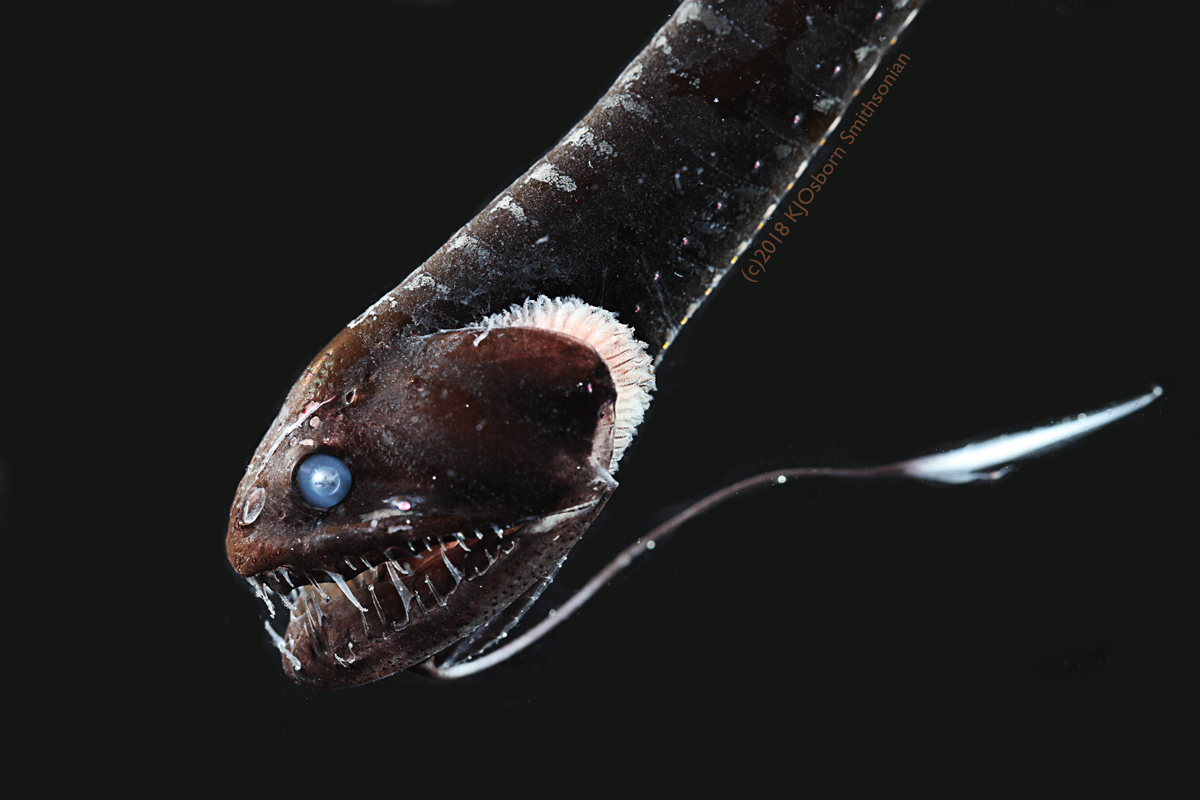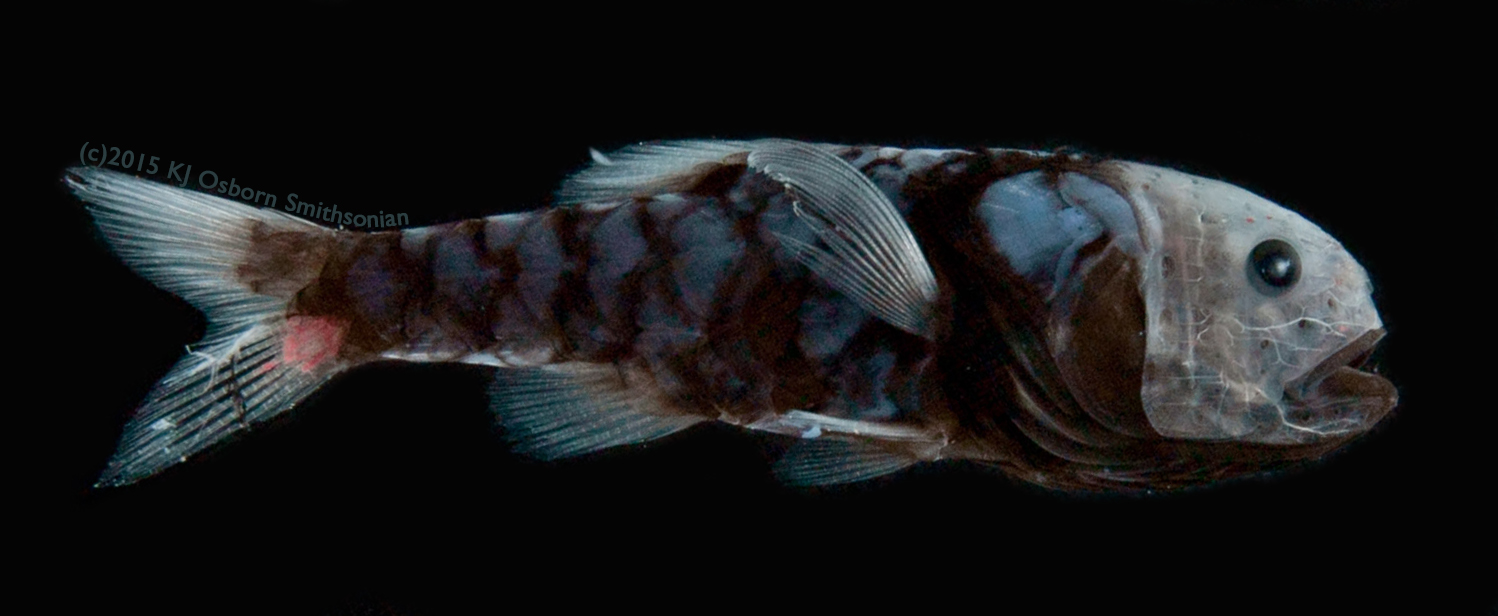Scientists Find First Ultra-Black Color in Deep-Sea Fishes

While out collecting invertebrates for research, Karen Osborn, a research zoologist and curator at the National Museum of Natural History and adjunct scientist at the Monterey Bay Aquarium Research Institute, often finds extra creatures in her trawl net and takes pictures of the ones that catch her eye. She’s an experienced photographer of marine life and frequently uses the photos for outreach at the museum. But over the years, she noticed something odd—while trying to take pictures of certain deep-sea fishes, she couldn’t capture any details, no matter what she tried. Instead, the fishes appeared as black silhouettes, absorbing any light she pointed at them.
Perplexed, she began to periodically collect tissue samples from the fishes and examine them with light and electron microscopy. “Every fish that I looked at had a similar shape, amount and location of the pigment in their skin,” Osborn said. “It was really weird, not like normal fish skin.”
Fish skin is layered and has cells that hold pigment in cellular components, or capsules. These capsules are called melanosomes, and they hold pigment, which absorbs light and makes the fish appear dark brown to black. The pigment, melanin, is also found in our skin, squid ink and many other places. In most fishes, the cells are in deeper layers of the skin and scattered around with space between them. But the fishes Osborn looked at had so many cells that they created a continuous layer right at the surface of the skin. The cells were full to overflowing with melanosomes tightly packed in.

In a paper published in “Current Biology,” Osborn and coauthors Sönke Johnsen and Alexander Davis from Duke University describe how the structure and arrangement of melanosomes render 16 species of fishes ultra-black, meaning they absorb at least 99.5 percent of light that hits them, and allows them to appear virtually invisible in the darkness of the deep sea. This is the first time ultra-black coloration has been found in aquatic animals.
The method of achieving ultra-blackness could provide an alternative to how man-made ultra-black materials are now produced, Osborn said. It could also mean developing alternative ways of absorbing not just light waves, but other waves too, like radio waves or X-rays and other forms of radiation.
The team tested the amount of light the fishes reflected and compared them to other ultra-black materials. Davis, who was responsible for the modeling, found that the blackest species reflected only 0.044 percent of light shone at it. This is blacker than ultra-black butterflies and about the same as the blackest birds-of-paradise. In comparison, black construction paper reflects about 10 percent of light.
Most terrestrial animals that have ultra-black patches use them to make their other colors stand out, which is important for signaling potential mates. But these fishes use their coloring for the opposite reason: to hide. Though little light penetrates the deep ocean, most deep sea animals produce bioluminescence. Ultra-black coloring helps fish evade predators’ search lights and also keeps predators from being illuminated by their own light as they attempt to lure in prey. Some fishes the team studied had ultra-black coloring only around their abdomen, which prevents their stomach from glowing after eating a bioluminescent meal.

Davis created a model simulating sunlight bouncing off a melanosome layer to test how changing the size and shape of the cells affected how they absorb light. He tested 169 combinations, finding that there was an optimal size and shape to reduce reflection of light.
“What we think is going on is that they're basically scattering light sideways, so that it's bouncing off even more of the melanin rather than just going back towards where the light was coming from,” he said. This is the only system the team knows of where the shape of the pigment granules themselves control how the light scatters. Most ultra-black materials use what Osborn describes as a “dual system,” — a structural light trap and a pigment. In this typical setup, some sort of matrix is used to trap light near a pigment. Light bounces around inside this matrix, giving the pigment more opportunities to absorb the light before it escapes. One of the blackest man-made materials uses extremely thin, vertical tubes packed tightly together in an ordered structure to trap the light until it’s absorbed by pigment. It’s effective, but it’s a delicate structure and very expensive to make, Osborn said. Right now, ultra-black coloring is used in products like cameras and high-powered telescopes to limit extra light inside their lenses.

Creating man-made ultra-black materials would be much simpler by mimicking how fishes trap light, Johnsen said. “There’s no order required. It’s what we call random close packed, which is a scientific way of saying it’s like a gumball machine. It's a pile of balls randomly arranged. All you need to do is make them, and somehow stick them all together.” In theory, the implications for this could be endless if scientists could find the right material and size of the “gumballs,” depending on the type of wave they want to absorb. Planes could be designed that are invisible to radar, coating could be created to protect from UV and X-rays and rooms could be made impenetrable to radio waves from cell phones.
And the research team only made this discovery because of what Johnsen calls an art project gone wrong. “I’m always a big fan of failure,” he said. “We failed to [take good photographs] and then that opened up a whole new area of research for us.”

